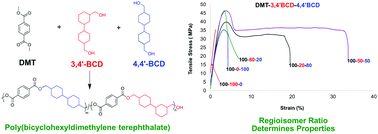Synthesis of poly(bicyclohexyldimethylene terephthalate): effect of regioisomer ratios on physical properties†
Abstract
A series of novel polyesters was synthesized from dimethyl terephthalate (DMT) and various ratios of two regioisomers of bicyclohexyldimethanol (BCD), 4,4′-BCD and 3,4′-BCD. NMR spectroscopy confirmed successful incorporation of all monomers into the polymer backbone. Differential scanning calorimetry revealed that the regioisomer content dictated the polymer morphology: Materials with a 4,4′-BCD content above 80% were semi-crystalline with melting temperatures ranging from 142 to 216 °C, while polymers with lower 4,4′-BCD content were amorphous. The amorphous density of the materials increased with increasing 3,4′-BCD content, which also corresponded to an increase in Young's modulus. High thermal stabilities were observed for all materials as evidenced by a consistent Td,5% around 390 °C. Dynamic mechanical analysis revealed glass transition temperatures of 108–114 °C for all compositions and sub-Tg β-relaxations with similar intensities, suggesting that the unsaturated rings play a key role in energy absorption at low temperatures. Tensile mechanical testing revealed that the 50% composition of both diols possessed the longest elongation at break at 34%, while homopolymers of either regioisomer had considerably less elasticity with elongations at break measured at <5%.



 Please wait while we load your content...
Please wait while we load your content...